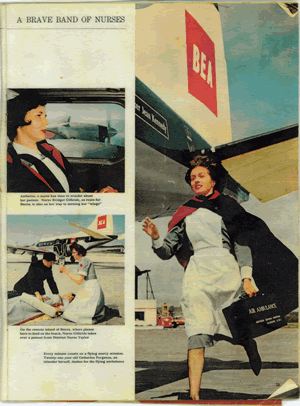| Looking Back Celebrating 73 years of the National Health Service in the Western Isles |
 The
introduction of the air ambulance was, and still is one of the most advantageous
services to remote Scottish communities.
The
introduction of the air ambulance was, and still is one of the most advantageous
services to remote Scottish communities.
In the 1960's I was privileged, as a final year student and later as a staff nurse in Glasgow Southern General Hospital, to participate in this service. The aircraft in use at this time was a De Havilland Heron normally used on Hebridean routes it could be converted in minutes for use as an air ambulance. As it was based at Renfrew airport, the nearby Southern General Hospital in Glasgow provided nurses for the flights. The plane was named after Sister Jean Kennedy, who tragically died in 1957 when the plane crashed on descent to Islay airport in atrocious weather conditions. In order to be allowed to fly we had to attend lectures, some of which were at the airport others at the hospital. We also had to familiarize ourselves with the outlay of the plane and what to do in an emergency. We were told about the effect of high altitudes on oxygen levels and how this could affect certain cases such as head injuries , heart conditions etc . The plane would then have to fly at lower altitudes. Before taking a flight on their own new recruits would go with an experienced nurse to learn the ropes . We would get asked to go on the air ambulance if we had finished our shift in the hospital, but had not yet gone home. I was always willing to go on a flight, but especially so when one day I was asked by Home Sister if I would go to Benbecula to pick up a patient. With little time to spare I made a quick call home to Balranald to tell my mother I was on my way to Benbecula, picked up my bag and rushed to the plane. My mother hired a car and got to the airport shortly before we landed. Dr Julia Macleod was also there with a thermos flask of coffee and sandwiches, which we were able to enjoy together in front of the coal fire before the plane took off again for Glasgow.
The air ambulance crew at the time consisted of the nurse along with the pilot and a radio officer. The Heron was equipped to carry stretchers and the only equipment we had was what we could carry in the medical bag. Despite this the flights usually had a happy outcome. In contrast my mother Nurse Catherine Ann Morrison's mode of transport, as a Queen's Institute of District Nurse in the late 1920's and early 1930's, was a bicycle. She lived in Grenitote and at times travelled quite some distance on it. In her role as midwife she made several trips to the Monach Isles (Heisgeir) which is 4 miles by boat from North Uist. On one such visit she stayed there for two weeks before the baby was delivered. The baby was Angus Macdonald now living in Knockintorran . She did however enjoy her stay there; the hospitality was next to none. At times she acted as relief for the Carinish nurse; this district also took in Grimsay. To get there she would cycle from Grenitote to Carinish , get the boat across to Grimsay and back then cycle back to Grenitote (38miles). On her way back from one of her visits to Grimsay, Dr Mackenzie (then GP for North Uist) was waiting for her in his chauffeur driven car at Hosta to ask her to continue on her bicycle to Newton Ferry to see a patient there! I don't know what she said other than that she would go in the morning . This she did and found the patient (a child ) outside with his mother and apparently in good health .
Sometimes we look back with nostalgia at the 'olden days', but I don't think we would like to give up the comparatively comfortable lifestyle we are now accustomed to.